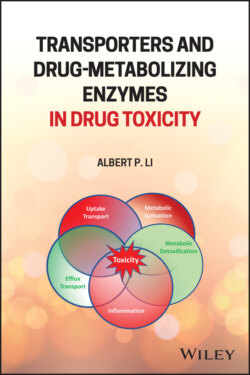Читать книгу Transporters and Drug-Metabolizing Enzymes in Drug Toxicity - Albert P. Li - Страница 71
3.7.1 Drug Metabolism and Toxicity
ОглавлениеAs a relatively new drug, there are limited numbers of publications on OCA metabolism. Its metabolism is likely to be similar to that known for bile acids. Bile acids are subjected to glucuronidation by the UDP‐glucuronosyltransferases (UGTs) 1A1, 2B4, and 2B7 and sulfation by sulfotransferases SULT2A1 and SULT2A8. The conjugated bile acids are secreted into bile via the canalicular bile salt export pump (BSEP), into the gastrointestinal tract. Some bile acids are passively absorbed in the upper intestine, but most are reabsorbed in the ileum as free bile acids upon deconjugation by the intestinal flora [144–146].
Five clinical drug–drug interaction studies have been reported on the effects of oral daily doses of 10 or 25 mg OCA on single‐dose plasma pharmacokinetics of specific probe substrates for enzymes CYP1A2 (caffeine, R‐warfarin), CYP3A (midazolam, R‐warfarin), CYP2C9 (S‐warfarin), CYP2D6 (dextromethorphan), CYP2C19 (omeprazole), and drug transporters, BCRP/OATP1B1/OATP1B3 (rosuvastatin), and P‐gp (digoxin). OCA was found to have no interactions with S‐warfarin, digoxin, and dextromethorphan, and weak interactions with caffeine, omeprazole, rosuvastatin, and midazolam [147]. The clinical findings therefore suggest that OCA does not significantly inhibit CY2C9, CYP2D6, CYP2C19, and CYP3A4.
The roles of OCA metabolism with its association of liver failures have not yet been defined. Primary cultured human hepatocytes were found to reproduce OCA activation of FXR leading to CYP7A suppression, but without associated cytotoxicity upon treatment for 72 hours with 0.1–100 μM of OCA, thereby suggesting that the clinical hepatotoxicity of OCA may not be a result of its direct cytotoxic effects [148, 149].
